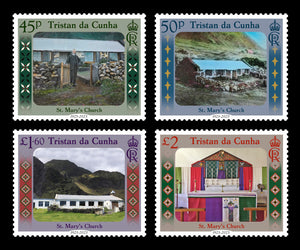FLAGS OF TRISTAN DA CUNHA
This new issue from Tristan da Cunha features various flags flown on the island over the centuries.
Jonathan Lambert's Flag Although Tristan was discovered in 1506, it was not until 1810 that the first attempt to settle the island was made by Jonathan Lambert from Salem, Massachusetts. Lambert pronounced himself sovereign of Tristan da Cunha and a proclamation was printed in the Boston Gazette of 18 July 1811. In that proclamation he adopted a flag for the islands.
Guidon of the 21st Light Dragoons The 21st Light Dragoons was a cavalry regiment of the British Army and between 1806 and 1816 it was stationed in the Cape Colony. They sailed for Tristan on HMS Falmouth in 1816. Corporal William Glass, an artillery driver, was part of the garrison. He, with his wife and children, stayed to become the founders of the new colony after the garrison left Tristan in 1817.
White Ensign of the Royal Navy The White Ensign, flown on Royal Navy ships and shore establishments, was used on the island initially in 1816, when it was officially annexed then from 1942 to 1944, when it was HMS Job 9, and from 1944 to 1946, when the island was HMS Atlantic Isle.
Current Tristan Flag The Tristan flag was assigned in a proclamation made on 20 October 2002 by Governor Hollamby under a Royal Warrant granted by Her Majesty Queen Elizabeth II.
Tristan Administrator's Flag - The Flag of the Tristan da Cunha Administrator is depicted on the FDC. It was also assigned in the October 2002 proclamation by Governor Hollamby.









